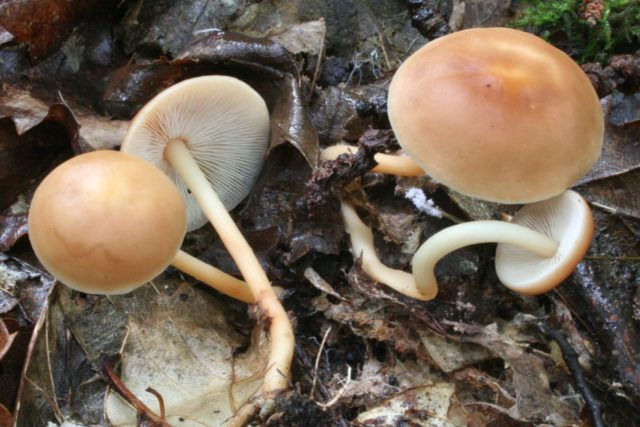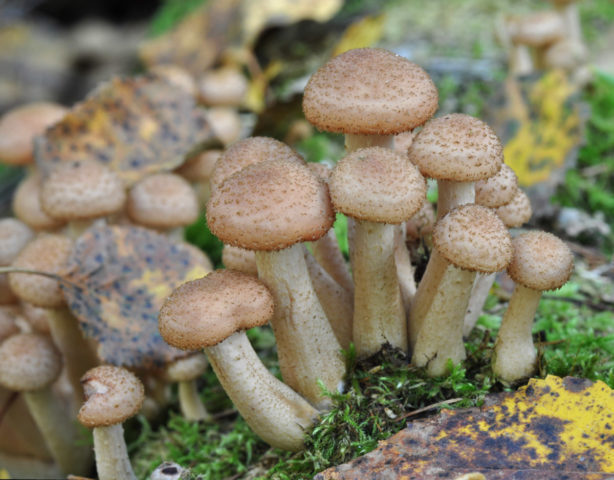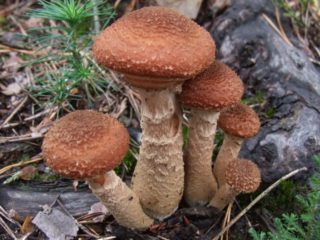Content
The Kursk region is one of those regions that can boast of many mushroom places. More than a hundred species are found here, but the most collected of them are honey mushrooms. Experienced mushroom pickers know that these mushrooms form entire families, and if they manage to find at least a few specimens, then their numerous relatives will certainly grow nearby. Honey mushrooms in the Kursk region are found throughout the season, provided favorable conditions exist, so you just have to figure out which species and in which area you can collect.
Types of edible honey mushrooms in Kursk and the region
These mushrooms are highly revered by many adherents of quiet hunting, despite the fact that they are inferior in taste to many species.This is due to the fact that their spongy pulp absorbs spices and marinades well, so they can be used to make preparations for the winter. In addition, they grow en masse, so if you find a mushroom spot, you can collect a whole basket in 5-10 minutes.
The main edible species growing in the Kursk region:
- Spring honey fungus or forest-loving money. Grows on mossy litter, rotten stumps and protruding tree roots. The color of the cap varies from reddish to yellow-brown. The diameter of the upper part reaches 3-7 cm, and the height of the stem is 5 cm. The taste is below average, but since they grow in a season when there are few mushrooms, interest in them increases significantly.
- Summer honey fungus. This species is distinguished by its increased taste and is often found. The fruiting period begins in June and lasts until October. The cap is flat-spread with a tubercle in the center, reddish-brown, reaches a diameter of 2-7 cm. The stem is woody, light brown in color, it is not used for food.
- Autumn is a real honey fungus. The most common species in the Kursk region. It can be harvested from the beginning of September until the end of November, subject to favorable conditions. It has high taste and is suitable for preparing winter preparations. The color of the cap can vary from mustard yellow to dark brown. In young specimens, there is a light film on the back of the upper part, which, after breaking, forms a ring on the stalk.
- Winter honey fungus or flammulina. This species bears fruit in colonies and is found fused. The mushroom grows at temperatures from 0 to +5 degrees. Fruiting begins in November and continues until the end of January. The cap of the winter honey mushroom is yellow-brown, but closer to the center it darkens.Its diameter reaches from 2 to 10 cm. Winter honey fungus is suitable for any processing.
Where do honey mushrooms grow in the Kursk region?
Honey mushrooms in the Kursk region are not difficult to find if you know where to look for them. Therefore, experienced mushroom pickers say that in the forest you need to move slowly and carefully inspect mossy stumps and trunks, and also look at the base of the trees.
In which forests do honey mushrooms grow in Kursk and the region?
Honey mushrooms in the Kursk region grow in any forest plantation or forest area. The favorite habitat of this species is fallen trunks, rotten stumps, and rotting trees.
They can also be found in a sunny clearing in the grass. This is due to the fact that many trees rot, and their roots extend far from the trunk. So it seems that mushrooms grow on the soil.
In which areas of the Kursk region do honey mushrooms grow?
In the Kursk region, there are several regions where, according to experienced mushroom pickers, you can definitely find productive places.
The following areas are suitable for lovers of quiet hunting:
- Kursk;
- October;
- Zheleznogorsk;
- Dmitrievsky;
- Oboyansky.
Forest areas where you can collect honey mushrooms in the Kursk region
Honey mushrooms grow in the forests of the Kursk region. not far from the Lvovskaya station near the village of Lagovskogo. In this place, especially in the open birch forest, numerous families of this species can be found. Also, the mushroom route extends from the village. Meshcherskoe to Kolkhoznaya station. On both sides of the road there is a forest where you can collect a large number of mushrooms.
Many experienced mushroom pickers recommend looking for honey mushrooms in the Kursk region in the forest near the settlements of Zhokhovo and Panino. In their opinion, there are a large number of mushroom places here, so collecting and stocking up will not be particularly difficult.
In Kursk there are also honey mushrooms in the forest area near the village of Nikonovo and further along the banks of the Rozhaya River.
When can honey mushrooms be collected in Kursk and the Kursk region in 2024
Collection in the Kursk region can be carried out at different times of the year, since all known edible species of these mushrooms grow in this region. But everything depends on the presence of favorable conditions for their growth.
When to collect spring and summer honey mushrooms in the Kursk region
The ripening period for the spring species in the Kursk region occurs at the beginning of May. It lasts throughout June and ends in July. But these dates may shift in the absence of seasonal precipitation, since in dry and hot weather the development of the mycelium is suspended.
Now in Kursk you can find summer honey mushrooms, as regular rains and moderate temperatures contribute to their massive growth. The fruiting period of this species begins in August and ends in October.
When autumn honey mushrooms grow in Kursk
Autumn honey mushrooms in the Kursk region in 2024 can be collected from the beginning of September to the end of October. The duration of this period depends on the onset of the first frost.
Winter mushroom collection season in the Kursk region
Winter honey mushrooms can be collected in Kursk from November and throughout the two months of winter. But the main condition for their growth is a temperature above 0 degrees. Therefore, it is worth going on a quiet hunt during the thaw.
Collection rules
When collecting, you should adhere to certain rules, which will help protect the mycelium from mechanical damage. A careful attitude will allow you to come back to your old place every year for a new portion of mushrooms.
When picking, mushrooms should not be pulled out, but rather cut with a knife.It is also allowed to unscrew each specimen from the mycelium by turning it around its axis. Among the family, it is worth selecting only young mushrooms, since the spongy pulp of overgrown ones can accumulate harmful toxins.
Picked mushrooms should first be cleared of grass and soil, and then placed in a basket with their caps up or on their side.
How to find out if honey mushrooms have appeared in the Kursk region
Experienced mushroom pickers advise going to a forest that is at least 30 years old to collect the harvest. It has already accumulated a large number of rotten stumps, on which this species prefers to grow.
Mycelium reproduction begins at a temperature of +3-+4 degrees. In this mode, the growth of the fungus continues for 30 days. The rate of germination largely depends on fluctuations in day and night temperatures.
The most favorable conditions for active mycelium growth are temperatures within +10-+26 degrees and moderate humidity. With this regime, the growth of the fungus continues for 6-8 days. Daily growth is 2-2.5 cm.
The main signs of their appearance:
- moderate air and soil humidity – within 55-60%;
- temperature within +10-+17 degrees without sudden changes.
Conclusion
Honey mushrooms in the Kursk region really grow in large numbers. But when going to the forest to collect a harvest, it is worth taking into account the timing of fruiting of different species and the presence of favorable conditions for their germination. And for beginners, it’s better to be patient, since it’s not always possible to find mushroom spots right away.













